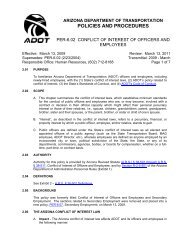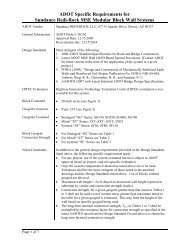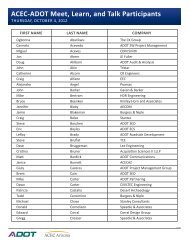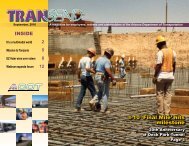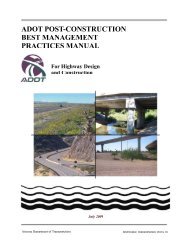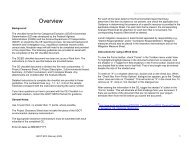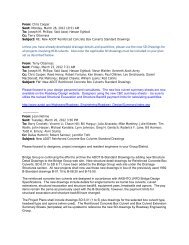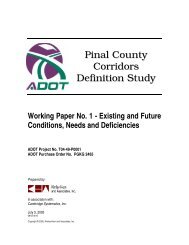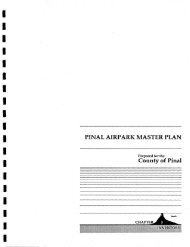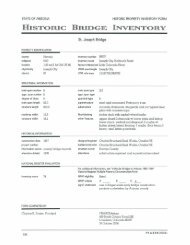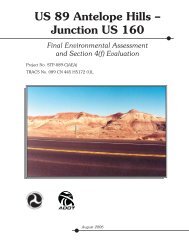I-10 Twin Peaks Traffic Interchange, Environmental Assessment
I-10 Twin Peaks Traffic Interchange, Environmental Assessment
I-10 Twin Peaks Traffic Interchange, Environmental Assessment
Create successful ePaper yourself
Turn your PDF publications into a flip-book with our unique Google optimized e-Paper software.
Affected Environment and <strong>Environmental</strong> Impacts October 2005<br />
visible structures to enhance the driver’s perception of Marana and to be in<br />
accordance with similar projects on I-<strong>10</strong> in the Tucson area.<br />
• During construction, the contractor would follow Arizona Department of<br />
Transportation’s Standard Specifications for Road and Bridge<br />
Construction, Section <strong>10</strong>4.09 Prevention of Landscape Defacement;<br />
Protection of Streams, Lakes and Reservoirs (2000 Edition) and the Water<br />
Quality Standards in Title 18, Chapter 11 of the Arizona Administrative<br />
Code as administered by the ADEQ.<br />
• Erosion control techniques such as slope rounding would be utilized, as<br />
necessary, to minimize impacts to visual quality.<br />
• The contractor would reduce visual impacts during construction by<br />
screening equipment storage and staging areas and by storing excavated<br />
material and debris in areas less visible to the public.<br />
• Intersection lighting would be designed to minimize light pollution of night<br />
skies and limit glare into neighborhoods.<br />
• Methods of reducing headlight impact to residents of Continental Ranch<br />
would be considered in final design.<br />
Conclusion<br />
As a result of the mitigation measures, visual impacts to the project area would be<br />
minimized and a visually enhanced traffic interchange would be developed that<br />
would blend with the surrounding area.<br />
Air Quality<br />
The EPA established National Ambient Air Quality Standards (NAAQS) for six<br />
criteria pollutants (ground level ozone (O3), carbon monoxide (CO), nitrogen<br />
dioxide (NO2), sulfur dioxide (SO2), particulate matter, and lead). Table 4-5<br />
presents the federal and state primary (health based) and secondary<br />
(aesthetic/economic based) standards for the pollutants of concern in the study area<br />
and the averaging period over which the standard is measured.<br />
Existing Conditions<br />
The Pima County Department of <strong>Environmental</strong> Quality (PDEQ) operates air<br />
quality monitoring stations at various sites throughout Pima County to monitor the<br />
levels of the two major air pollutants of concern in this area: particulates (PM<strong>10</strong><br />
and PM2.5), and CO. The closest of these monitoring stations to the study area is<br />
9597 North Coachline Boulevard, approximately 2,000 feet north of <strong>Twin</strong> <strong>Peaks</strong><br />
Road. This monitor was established in March of 2001 to determine fine particle<br />
concentrations in a residential neighborhood. The most recent reported results<br />
from this site is compared to the NAAQS in Table 4-6.<br />
Interstate <strong>10</strong> <strong>Traffic</strong> <strong>Interchange</strong> at<br />
<strong>Twin</strong> <strong>Peaks</strong>/Linda Vista<br />
4-45<br />
Project No.: NH-0<strong>10</strong>-D (AIW)<br />
TRACS No.: <strong>10</strong> PM 236 H5838 01D



